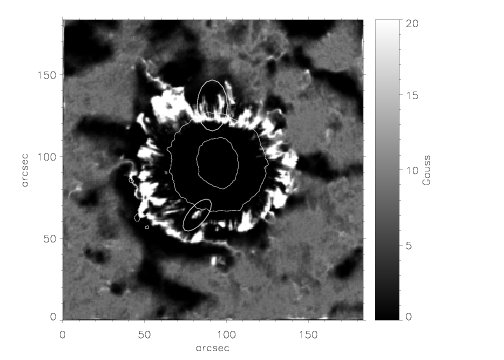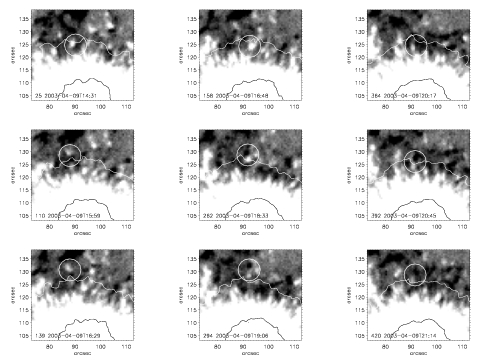MMFs and Penumbral Filaments In
this page we present the results
published in ApJ (ApJ 632:1176-1183, 2005 October 20) (PDF - PS) ABSTRACT:
A sequence of 633 high
spatial resolution magnetograms and continuum images from SoHO/MDI of
NOAA 0330
is used to study MMF activity in the moat surrounding a mature leader
sunspot. The time-averaged frame shows that the moat region is covered
by a magnetic field that exhibits the same polarity distribution
observed in the penumbra. The moat field displays the true polarity of
the spot in the sector where the penumbra displays it. Similarly, on
the side where the penumbra shows a polarity opposite to the true one
(due to projection effects after the
so-called apparent neutral line), the moat field also displays a
polarity
opposite to the true one. This is only compatible with a moat field
that
is horizontal almost everywhere, as in the outer penumbra. Indeed, this
horizontal moat field is seen to be physically connected with the
penumbra. This connection is made evident when analyzing the individual
structures detected in the
averaged images, that we call moat filaments. The filaments stretch
out
for 12 arcsec in the moat and can be traced back into the penumbra. The
observed polarity distribution along them is only compatible with mean
inclinations in the range of 80-90 degrees. Inside the spot, these
filaments are linked to the more horizontal magnetic field component
that is thought to carry
a large part of the Evershed flow. Several bipolar MMFs are seen to
originate inside the penumbra and cross the sunspot outer boundary to
enter the moat region, following the paths outlined by the moat
filaments. These results are discussed in the frame of our current
theoretical understanding of the Evershed flow and MMF activity.
|
Extra
material NOT PUBLISHED in the ApJ paper. Author: A. Sainz Dalda (asainz@themis.iac.es) Last modified: 14/10/2005 |







